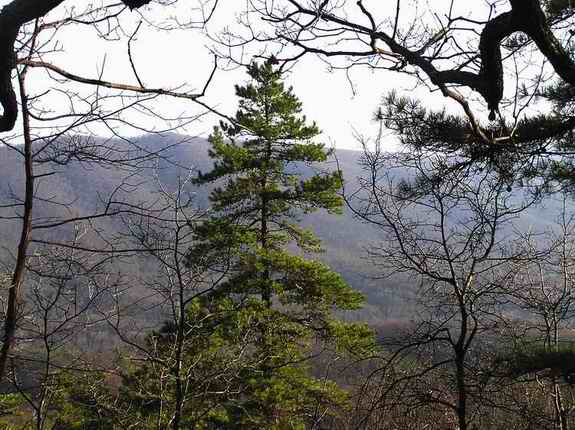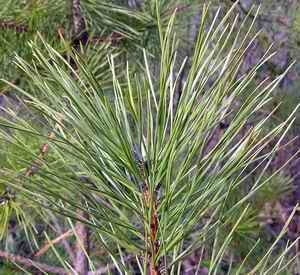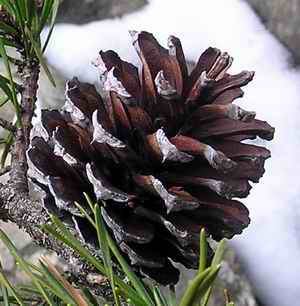|
Return to Hiker's Notebook Home Page
Common Name: Virginia Pine, Jersey pine, North Carolina pine, scrub pine, poverty pine, bastard pine, old-field pine, spruce pine, short shucks, shortleaf pine, black pine, cedar pine, hickory pine, river pine, alligator pine, possum pine. Scientific Name: Pinus virginiana - The generic name is Latin for pine tree and the species is a Latinized form for Virginia, where the tree was first identified (virgineus is Latin for 'of a virgin,' Virginia being named for "the virgin queen," Elizabeth I)
The many common names of the Virginia pine are a result of its geographical dispersion, hardiness, and extensive historical use as a commercial lumber tree. Its range extends in a wide band from southern New York to northeast Mississippi; the names Jersey pine and North Carolina pine are evidence of large populations in the intervening states. It is a pioneer plant that thrives in soils that are inhospitable to most other plants, forming dense thickets of scraggly saplings in the meager habitat; earning the common name scrub pine. Its use to cover barren hillside habitats such as those left after strip mining and other infertile fields and farmlands earned it the sobriquet poverty pine and perhaps the more pejorative bastard pine. The name old-field pine sums up its association with desiccated and abandoned open areas. The ubiquity of the Virginia pine also lends it a collection of names that mark its association with a variety of other trees or are characteristic of its general appearance. Spruce pine and cedar pine are indicative of a general lack of specificity in evergreen identification and perhaps some similarities in appearance that may suggest common ancestry (e.g. eastern red cedar is really a juniper). In the Appalachian Mountains, it is associated with two pine trees that occupy similar habitats. The pitch pine (P. rigida) has three needles in each bundle instead of two and tends to inhabit less xeric areas than Virginia pine. The Table Mountain pine (P. pungens) has two needles and tends to inhabit exposed mountain ridges at higher elevations than Virginia pine. P. virginiana has short, twisted needles (right) that are in bundles of two, resulting in the names short shucks and shortleaf pine
Historically, Virginia pine has been used for timbers to prop up mine ceilings, as railroad ties, as general rough framing lumber, and for a variety of derivative products including tar and charcoal. In recent years, however, it has gained importance as a source of pulpwood. This is in part due to its ability to rapidly reforest abandoned agricultural lands and areas that have had coal and other minerals extracted by open-pit or strip mining. For example, Virginia pine was evaluated on a 50 year rotation against shortleaf and loblolly pines in areas with shallow soils and found to outperform them by over 4,000 board feet per acre. Through some extensive genetic improvement programs initiated in the 1980's by the Texas Forest Service and Alabama A&M University, Virginia pine has also become one of the primary sources of Christmas trees in the southern states. The ungainly tree was subject to progeny tests and selective breeding to produce an appropriately ramose tree for seasonal festooning.
Virginia pine is also an important habitat and food source for a number of birds and mammals. It is a favorite nesting site for woodpeckers due to relatively soft wood in the older trees. The seeds are consumed by many small mammals and notably by the northern bobwhite. The foliage is an important food source for the white-tailed deer. Virginia pine is not well adapted to survive fire, as it has thin bark and shallow roots. It is, however, an aggressive pioneer of burned sites. For example, the density of Virginia pine seedlings after a hot surface fire was found to be 10,750 per acre, compared to 250 per acre on unburned plots. It is thought that Indians prior to colonization maintained large tracts of pine forests through intentional burning as a means to encourage agricultural growth and to establish wildlife habitats. |


 The
Virginia pine is monoecious, having both male and female reproductive
capabilities on the same tree. The male cones occur in clusters in the lower
crown and release pollen in May. The female cones (left) are produced in
clusters near the tips of new shoots and are pollinated in June, maturing and
releasing seed in September through November of the following year. Female
cones, unlike most other pines, are produced throughout the crown and give the
tree its characteristic appearance of being thick with cones by which it can
readily be identified. The density of the female cones is due to their
senescence. After they release their seed, they can persist on the tree for as
long as 15 years.
The
Virginia pine is monoecious, having both male and female reproductive
capabilities on the same tree. The male cones occur in clusters in the lower
crown and release pollen in May. The female cones (left) are produced in
clusters near the tips of new shoots and are pollinated in June, maturing and
releasing seed in September through November of the following year. Female
cones, unlike most other pines, are produced throughout the crown and give the
tree its characteristic appearance of being thick with cones by which it can
readily be identified. The density of the female cones is due to their
senescence. After they release their seed, they can persist on the tree for as
long as 15 years.